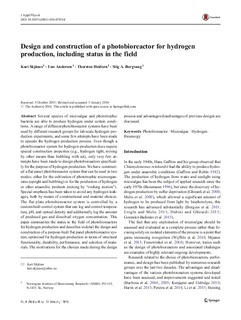| dc.contributor.author | Skjånes, Kari | |
| dc.contributor.author | Andersen, Uno | |
| dc.contributor.author | Heidorn, Torsten | |
| dc.contributor.author | Borgvang, Stig | |
| dc.date.accessioned | 2016-02-01T14:16:35Z | |
| dc.date.accessioned | 2018-05-29T08:54:34Z | |
| dc.date.available | 2016-02-01T14:16:35Z | |
| dc.date.available | 2018-05-29T08:54:34Z | |
| dc.date.issued | 2016 | |
| dc.identifier.citation | Skjånes, K., Andersen, U., Heidorn, T. et al. J Appl Phycol (2016) 28: 2205 | nb_NO |
| dc.identifier.issn | 1573-5176 | |
| dc.identifier.uri | http://hdl.handle.net/11250/2499519 | |
| dc.description.abstract | Several species of microalgae and phototrophic bacteria are able to produce hydrogen under certain conditions. A range of different photobioreactor systems have been used by different research groups for lab-scale hydrogen production experiments, and some few attempts have been made to upscale the hydrogen production process. Even though a photobioreactor system for hydrogen production does require special construction properties (e.g., hydrogen tight, mixing by other means than bubbling with air), only very few attempts have been made to design photobioreactors specifically for the purpose of hydrogen production. We have constructed a flat panel photobioreactor system that can be used in two modes: either for the cultivation of phototrophic microorganisms (upright and bubbling) or for the production of hydrogen or other anaerobic products (mixing by “rocking motion”). Special emphasis has been taken to avoid any hydrogen leakages, both by means of constructional and material choices. The flat plate photobioreactor system is controlled by a custom-built control system that can log and control temperature, pH, and optical density and additionally log the amount of produced gas and dissolved oxygen concentration. This paper summarizes the status in the field of photobioreactors for hydrogen production and describes in detail the design and construction of a purpose-built flat panel photobioreactor system, optimized for hydrogen production in terms of structural functionality, durability, performance, and selection of materials. The motivations for the choices made during the design process and advantages/disadvantages of previous designs are discussed. | nb_NO |
| dc.language.iso | eng | nb_NO |
| dc.rights | Navngivelse 4.0 Internasjonal | * |
| dc.rights.uri | http://creativecommons.org/licenses/by/4.0/deed.no | * |
| dc.subject | Photobioreactor | nb_NO |
| dc.subject | Microalgae | nb_NO |
| dc.subject | Hydrogen | nb_NO |
| dc.subject | Bioenergy | nb_NO |
| dc.title | Design and construction of a photobioreactor for hydrogen production, including status in the field | nb_NO |
| dc.type | Journal article | nb_NO |
| dc.type | Peer reviewed | nb_NO |
| dc.date.updated | 2016-02-01T14:16:35Z | |
| dc.description.version | publishedVersion | nb_NO |
| dc.rights.holder | The Author(s) 2016. This article is published with open access at Springerlink.com | nb_NO |
| dc.source.pagenumber | 2205–2223 | nb_NO |
| dc.source.volume | 28 | nb_NO |
| dc.source.journal | Journal of Applied Phycology | nb_NO |
| dc.source.issue | 4 | nb_NO |
| dc.identifier.doi | 10.1007/s10811-016-0789-4 | |
| dc.identifier.cristin | 1330141 | |

